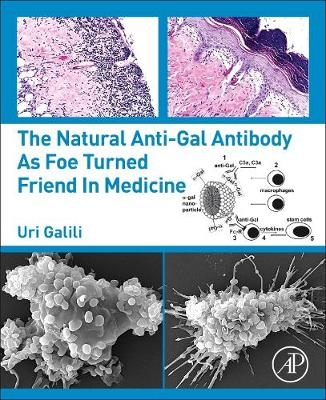
The Natural Anti-Gal Antibody as Foe Turned Friend in Medicine
Academic Press Inc (Verlag)
978-0-12-813362-0 (ISBN)
Some of these therapies are described as experimental studies that are compiled in this book, other already studied therapies in the area of cancer immunotherapy are also included in this book.
Uri Galili is an immunologist who received his PhD in 1977 at the Hebrew University School of Medicine, Jerusalem, Israel. Following postdoctoral research at the Karolinska Institute, Stockholm (1977-1979), he worked at Hadassah University Hospital, Jerusalem (1979-1984), where he discovered anti-Gal as the most abundant natural antibody in humans. In collaboration with Bruce Macher at University of California Medical Center, San Francisco (1984-1990), he identified the a-gal epitope as the mammalian antigen that binds anti-Gal, determined the unique evolution of anti-Gal and a-gal epitopes in primates and studied the molecular basis for this evolution. In MCP-Hahnemann School of Medicine, Philadelphia (1991-1999), he studied the significance of anti-Gal/a-gal epitope interaction as an immune barrier in xenotransplantation and initiated studies on harnessing anti-Gal in cancer immunotherapy and in amplifying immune response to viruses. At Rush Medical School, Chicago (1999-2004), he studied immune tolerance induction to a-gal epitopes. In the Department of Surgery at UMass Medical School, Worcester (2004-2013), he developed a method for in situ conversion of tumors into autologous vaccines targeted to antigen-presenting cells by intratumoral injection of a-gal glycolipids, performed clinical trials with this immunotherapy and demonstrated increased immunogenicity of influenza and HIV vaccines presenting a-gal epitopes. He further developed anti-Gal binding a-gal nanoparticles that accelerate wound and burn healing and induce tissue regeneration in internal injuries. Prof. Galili retired in 2013 and lives in Chicago. He continues his research as a volunteer Adjunct Professor at Rush Medical School, on a-gal nanoparticles induced regeneration of ischemic myocardium, post myocardial infarction.
SECTION 1: ANTI-GAL BACKGROUND1. Anti-Gal in humans and its antigen the a-gal epitope2. Why do we produce anti-Gal: Evolutionary appearance of anti-Gal in Old World primates3. Anti-Gal comprises most of anti-blood group B antibodies: Landsteiner’s enigma4. Anti-Gal interaction with Trypanosoma, Leishmania and Plasmodium parasites5. Anti-Gal B cells are tolerized by a-gal epitopes in the absence of T cell help
SECTION 2: ANTI-GAL AS FOE6. Anti-Gal and other immune barriers in xenotransplantation7. Anti-Gal IgE mediates allergies to red meat8. Anti-Gal and autoimmunity
SECTION 3: ANTI-GAL AS FRIEND9. Anti-Gal mediated amplification of viral vaccine efficacy 10. Cancer immunotherapy by anti-Gal mediated in situ conversion of tumors into autologous vaccines11. Anti-Gal as cancer cell destroying antibody and as antibiotics targeted by a-gal bi-functional molecules12. Acceleration of wound and burn healing by anti-Gal/a-gal nanoparticles interaction
SECTION 4: FUTURE HYPOTHETICAL DIRECTIONS13. Anti-Gal and anti-non gal antibodies in regeneration of extracellular matrix (ECM) bio-implants in humans 14. Post infarction regeneration of ischemic myocardium by intramyocardial injection of a-gal nanoparticles15. Regeneration of injured spinal cord and peripheral nerves by a-gal nanoparticles16. Inhalation of a-gal/sialic acid liposomes for decreasing influenza virus infection
| Erscheinungsdatum | 22.09.2017 |
|---|---|
| Verlagsort | San Diego |
| Sprache | englisch |
| Maße | 191 x 235 mm |
| Gewicht | 660 g |
| Themenwelt | Medizin / Pharmazie ► Medizinische Fachgebiete ► Mikrobiologie / Infektologie / Reisemedizin |
| Studium ► Querschnittsbereiche ► Infektiologie / Immunologie | |
| Naturwissenschaften ► Biologie ► Mikrobiologie / Immunologie | |
| ISBN-10 | 0-12-813362-7 / 0128133627 |
| ISBN-13 | 978-0-12-813362-0 / 9780128133620 |
| Zustand | Neuware |
| Haben Sie eine Frage zum Produkt? |
aus dem Bereich


